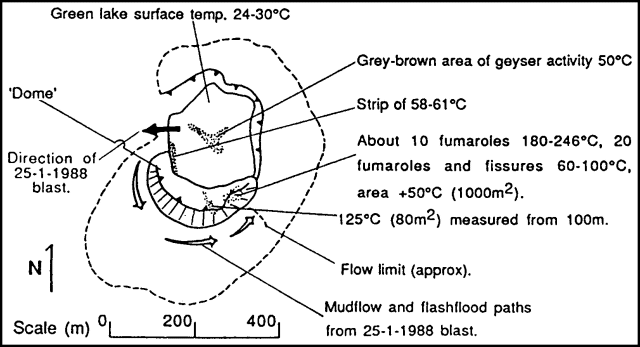Report on Poas (Costa Rica) — January 1988
Scientific Event Alert Network Bulletin, vol. 13, no. 1 (January 1988)
Managing Editor: Lindsay McClelland.
Poas (Costa Rica) Explosions from crater lake
Please cite this report as:
Global Volcanism Program, 1988. Report on Poas (Costa Rica) (McClelland, L., ed.). Scientific Event Alert Network Bulletin, 13:1. Smithsonian Institution. https://doi.org/10.5479/si.GVP.SEAN198801-345040
Poas
Costa Rica
10.2°N, 84.233°W; summit elev. 2697 m
All times are local (unless otherwise noted)
Geologists from the Instituto Costarricense de Electricidad (ICE) and the Open University visited the volcano several times in January. ICE geologists reported that phreatic explosions from the center of the crater lake were generally small, sending silt-rich material to less than 10 m height. Explosions were occasionally laterally directed. A few ejected dark gray, mud-rich, cypressoid columns to 50 m above the lake, without premonitory activity. There was some tendency for explosions to occur in groups of two to 3 about 1 minute apart, separated from other explosions by 5 minutes or more. On 20 January, Open University geologists saw geyser-like eruptions every 10-30 minutes that reached 40 m height. Columns emerged from more than one point near the center of the lake. The explosions were occasionally laterally directed, as on 25 January at about 1300, when a large quantity of water was thrown onto the W crater wall, generating small mudflows and flash floods that passed S of the 1953-55 [dome] (figure 1). Shallow seismicity has been recorded by the Poás station (VPS) of the Red Sismológica Nacional.
Water temperatures at the surface of the dark green crater lake reached 61-63°C below the W flank of the 1953-55 [dome]. Fumarole temperatures measured by ICE personnel on the [dome] were about 400°C. Terraces formed from sedimentary precipitates (travertine and sulfur) had been eroded away. Lake level had dropped markedly since 1987. The parallel fractures on the E and NE edges of the lake showed small displacements. Other parallel fractures between the edge of the [dome] and the lake were sites of more vigorous fumarolic activity.
Geological Summary. The broad vegetated edifice of Poás, one of the most active volcanoes of Costa Rica, contains three craters along a N-S line. The frequently visited multi-hued summit crater lakes of the basaltic-to-dacitic volcano are easily accessible by vehicle from the nearby capital city of San José. A N-S-trending fissure cutting the complex stratovolcano extends to the lower N flank, where it has produced the Congo stratovolcano and several lake-filled maars. The southernmost of the two summit crater lakes, Botos, last erupted about 7,500 years ago. The more prominent geothermally heated northern lake, Laguna Caliente, is one of the world's most acidic natural lakes, with a pH of near zero. It has been the site of frequent phreatic and phreatomagmatic eruptions since an eruption was reported in 1828. Eruptions often include geyser-like ejections of crater-lake water.
Information Contacts: Sergio Moro Castro, ICE; B. van Wyk de Vries, H. Rymer, and G.C. Brown, Open Univ.


